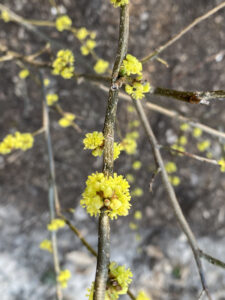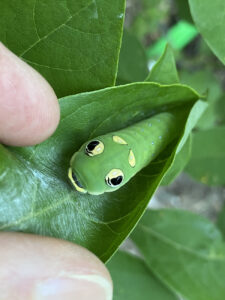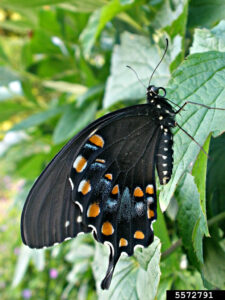NATIVES TO KNOW
American Spicebush, Lindera benzoin
By Joyce Tuharsky, WORC Member
Consider spicing up your landscape with native American Spicebush, and you can spice up your morning tea as well. A deciduous shrub, Spicebush is a member of the laurel family. It grows 6–12 foot tall, has many trunks, and spreads by roots. The leaves are dark green, oval-shaped with smooth edges, and grow up to 5 inches long; although the leaves next to fruits on second-year wood are smaller and rounder. In autumn, the leaves turn a pretty golden yellow.

Spicebush has been called the “Forsythia of the Wilds,” because of its clusters of tiny greenish-yellow flowers that bloom along the branches in early spring before leaves emerge, giving a yellow tinge to many low woodland forests. Spicebush is a dioecious plant (separate male and female plants), with the male flowers being larger and showier than the female. The flowers of female plants give way to bright red drupes, up to 1/2″ long, which mature and are very attractive in fall, although largely hidden until the leaves drop.
Crush or scratch any part of a Spicebush plant to release its spicy-lemony fragrance that has been compared to Allspice. In fact, Spicebush has been used to flavor tea, pastries, jams, main courses, and even perfumes. American settlers used the dried bark in place of cinnamon. Native Americans used various parts of the plant for medicinal purposes. The drupes are the spiciest part of the plant, but even the clusters of tiny flowers will scent the air in spring.
In the wild, Spicebush is often an understory plant found in damp, partially shaded woodland areas and along streams. For early pioneers, it was a sign of rich fertile soil for farming. In spring, the flowers are an excellent source of nectar for butterflies and other native pollinators. In particular, Spicebush is an important host to butterflies in the swallowtail family, especially the Spicebush Swallowtail and the eastern tiger Swallowtail. The ripe red drupes are one of the best sources of energy for long distance migratory birds in fall. Throughout the year, this bush provides nesting for birds and cover for rabbit, chipmunks, and small mammals.


Spicebush is easy to grow, well-suited to those shady, wet areas where other more traditional landscape shrubs often fail. It is excellent for shrub borders, moist areas along streams or ponds, or woodland gardens with naturalized plantings. While preferring moist sandy loam soils, it will adapt reasonably well to drier soils in sunny locations where its growth will be denser. The fibrous root system transplants easily, helped along by copious amounts of water. Spicebush is deer resistant and suffers from no serious insect or disease problems.
More information and photos available at:
https://www.wildflower.org/plants/result.php?id_plant=libe3
https://ohiodnr.gov/discover-and-learn/plants-trees/broad-leaf-trees/Spicebush-Lindera-benzoin
http://www.grit.com/Property/American-Spicebush.aspx
SPICEBUSH TEA
Twigs are best gathered in spring when the sap is at its highest concentration.
Ingredients:
- Enough spicebush twigs, striped of leaves and broken into lengths of approximately 5 inches, to fill a 3-quart pan
- 2½ quarts water
- 2 tablespoons honey
Fill pan with twigs and water, and bring to a boil, uncovered. After about 25–30 minutes, water should be slightly yellow. Strain tea through colander into gallon container. Stir in honey. Tea will keep in refrigerator for a week. Serve hot. Enjoy!
